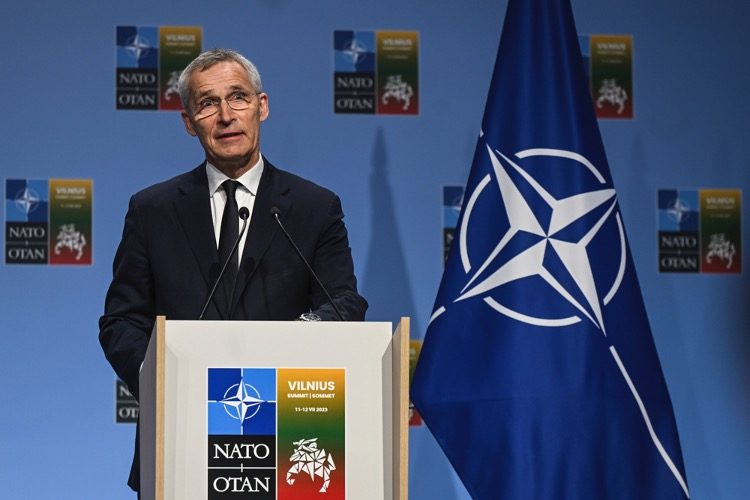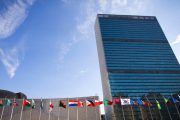
On September 17, NATO Secretary General Jens Stoltenberg warned Western countries to prepare for “a long war” in Ukraine, and that he backed Ukrainian President Volodymyr Zelensky’s aim of a military triumph over Russia. The NATO leader made these statements despite alleging that he wanted a “quick peace” in Ukraine.
“Most wars last longer than expected when they first begin,” Stoltenberg declared in an interview with Germany’s Funke media group. “Therefore we must prepare ourselves for a long war in Ukraine.”
Based on media reports over the last two months, Western officials and military planners have admitted that Ukraine’s present counteroffensive against Russian forces is likely to fail.
Russian President Vladimir Putin has claimed that Ukraine has lost over 71,000 men since the counteroffensive commenced in June this year. Notwithstanding such sobering attrition figures, with Ukrainian media sources stating that some units have lost 90 percent of their manpower, Stoltenberg maintained that NATO will persist in lobbying for a military solution instead of a diplomatic one.
“We are all wishing for a quick peace,” Stoltenberg said. “But at the same time we must recognise: if President Zelensky and the Ukrainians stop fighting, their country will no longer exist. If President Putin and Russia lay down their weapons, we will have peace.”
After dismissing a Turkish-brokered peace deal last April, Zelensky published a decree banning all peace talks with Russia. Furthermore, the Ukrainian leader has constantly pledged to recapture the former Ukrainian regions of Donetsk, Lugansk, Kherson, and Zaporozhye, as well as Crimea, the latter of which voted overwhelmingly to join Russia in 2014.
Washington, where officials have alleged that only the Ukrainian leader can determine when to seek peace, has repeatedly displayed support for Zelensky in his actions against Russia. Also, U.S. Secretary of State Antony Blinken has decried Putin for reportedly abandoning “meaningful diplomacy.”
On its end, Russia has insisted that it is ready for a diplomatic solution to the conflict in Ukraine. However, any negotiations would have to consider the “new territorial reality” — that Donetsk, Lugansk, Kherson, Zaporozhye, and Crimea will never be given back to Ukraine. Additionally, Russian Foreign Minister Sergey Lavrov has declared that peace talks would be conducted “not with Zelensky, who is a puppet in the hands of the West, but directly with his masters.”
Ukraine’s head of the National Security and Defense Council, Aleksey Danilov, penned an opinion piece published on September 16 in the Ukrainskaya Pravda newspaper stating that his country is undermined by the slow unraveling of its “carefully woven web of foreign assistance” due to rising disillusionment among its Western backers.
The security chief slammed “reputable and influential” Western media outlets for publishing information hinting that Ukraine’s summer counteroffensive was failing, that Kyiv’s troops could not recapture territory from Russia, and Moscow’s resources were “limitless.”
These materials dampen Western military aid to Kyiv and impede Ukraine’s “peace formula,” Danilov added.
Danilov then suggested that the only way out of the clash between Moscow and Kyiv was a military solution. “The peace formula is the weapons formula,” he argued in the article.
Furthermore, Danilov called for the West to address its own growing disappointment about Ukraine’s performance in the conflict.
Western nations should set up their “agreed formula for … the vision of Ukraine’s victory” and also “enshrine military assistance to Ukraine in … legislation,” he proposed, adding that election schedules might influence “the stability of the partnership” between Ukraine and the West.
Moreover, the United States and its allies should “develop and implement a set of measures to neutralize so-called ‘war fatigue,’” Danilov reinforced.
Danilov’s article came more than three months into the Ukrainian counteroffensive, and after various Western media outlets have reported on rising doubts among Western officials about Ukraine’s abilities in its counteroffensive. Danilov also alluded to Zelensky’s own “peace formula” — which includes the departure of Russian troops from all territories claimed by Kyiv, reparations from Moscow, and a criminal tribunal for Russian government officials.
The New York Times reported in August that U.S. and U.K. officials were “perplexed” by Kyiv’s strategies, whereas The Wall Street Journal declared Washington would cut military aid to Ukraine in 2024.
Washington’s widespread campaign to back Ukraine with arms equates to a war against Russia, Foreign Minister Sergey Lavrov declared September 17, elaborating that the United States has long prepared Kyiv for this very purpose.
In a statement to Russian reporter Pavel Zarubin, Lavrov suggested that speculations about Washington possibly approving the delivery of Army Tactical Missile Systems (ATACMS), which have a range of up to 300km, were meant to influence “public opinion.”
Lavrov claimed that these considerations would not alter the reality that “for many years Ukraine has been groomed to fight with its hands and bodies in order to inflict a strategic defeat on Russia,” slamming the United States for stoking animosities between Kyiv and Moscow.
Various Western media outlets have recently reported that the administration of Joe Biden is on the verge of greenlighting deliveries of the ATACMS, which Kyiv has been requesting for several months. The United States has been hesitant to deploy these missile systems, stating that potential Ukrainian strikes deep into Russia could provoke a major intensification of the conflict.
Ukraine has already received long-range missiles from the U.K. and France, which, based on local officials, have been used to assault civilian targets and infrastructure in Russia’s Crimean Peninsula and Donbass.
As NATO countries earmarked tens of billions of dollars worth of weapons and ammunition for Ukraine since last February, Western leaders enforced strict sanctions on Russia to undermine its defense industry. However, U.S. officials have reportedly admitted that Russia is now manufacturing more missiles than it was before the conflict began.
While the sanctions curbed Russian missile output for around six months after Moscow launched its military offensive against Kyiv, the country’s defense contractors later managed to reinstate and even raise their production capacity, The New York Times declared, quoting unnamed U.S. officials.



